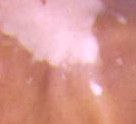Team:Stockholm/Ideas
From 2010.igem.org
| Home | Team | Ideas | Journal club | Sponsors |
|---|
Ideas
We constantly get new ideas and reject old ones! Here is four ideas that we have hope in right now.
Vitiligo
Vitiligo (leukodermi) is a disorder which causes affected parts of the skin to turn white. This is due to abnormal melanocyte function, probably due to the immune system mistakenly targeting the pigment cells. Vitiligo usually begins before the age of 20 and is estimated to affect 0,5-2% of the world population. Vitiligo is a very complex disorder and there is a lack of good treatments. We want to approach this disorder in several ways with the aim to re-pigment the skin.
Colon cancer
Colon cancer is one of the most common forms of cancer. It normally affects old people. Colon cancer develops in the mucous membrane of the intestine, from a wound or an outgrowth (polyp). Current treatments of colon cancer are based on surgical removal of the affected colon section. In addition, chemotherapy may be used depending on the character of the cancer. Although surgery will most likely continue to be the primary treatment for colon cancer, synthetic biology allow us a new approach to chemotherapy which we believe has a promising future.
Herpes
Some members of the herpes virus family infect humans. The symptoms of this virus infection are watery blisters in the skin or in mucous membranes of the mouth, lips or genitals. After the initial infection, some infected people get sporadic viral outbreaks. Current treatments for infection do not cure the patients, instead they reduce the likelihood of viral shedding and spread by using antiviral drugs that interfere with the viral replication. We have two approaches, one in where we screen for herpes infection and one in where we produce chemicals reducing the outburst of the virus.
Diabetes
The hormone insulin is normally produced by specialized beta cells located in the pancreas. As blood glucose levels rise after a meal, these cells begin to secrete insulin into the blood. Insulin then stimulates glucose uptake in e.g. the liver, thereby lowering the blood glucose levels. In diabetes type I, the beta cells are destroyed by the body’s own immune system. As a result, the body is unable to produce insulin, leading to high glucose levels in the blood - a fatal condition unless treated. Today, diabetes type I treatment generally involves manually injecting insulin into the blood after each meal. We want bacteria that can do the work of the non-functional beta cells.
 "
"

